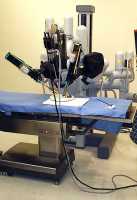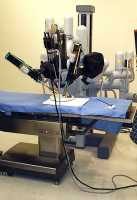
03 Sep Robotic Surgery More Expensive But May Not Have Better Outcomes Than Traditional Surgery
MedicalResearch.com Interview with:
 Chris Childers, M.D.
Chris Childers, M.D.
Division of General Surgery
David Geffen School of Medicine at UCLA
10833 Le Conte Ave., CHS 72-247
Los Angeles, CA 90095
MedicalResearch.com: What is the background for this study? What are the main findings?
Response: The robotic surgical approach has gained significant traction in the U.S. market despite mixed opinions regarding its clinical benefit. A few recent randomized trials have suggested there may be no clinical benefit of the robotic approach for some surgical procedures over the more traditional open or laparoscopic (“minimally-invasive”) approaches.
Previous studies have also suggested the robotic approach is very expensive, but until our study, there was no benchmark for the true costs (to the hospital) of using the robotic platform.
Our study analyzed financial statements from the main supplier of robotic technology. We found that the use of robotic surgery has increased exponentially over the past decade from approximately 136 thousand procedures in 2008 to 877 thousand procedures in 2017. The majority of these procedures were performed in the United States. While most people think of the robotic approach in urologic and perhaps gynecologic surgery, the fastest growing segment has been general surgery, for procedures such as colorectal resections, hernia repairs and gallbladder removals. In total, over 3 billion dollars was spent by hospitals to acquire and use robotic platforms in 2017 with 2.3 billion dollars in the United States. This equates to nearly $3,600 per procedure performed.
MedicalResearch.com: Is robotic surgery any faster than traditional methods?
Response: While there may be exceptions, robotic surgery is generally considered slower than traditional methods. As a result, not only is the acquisition and use of the robotic platform expensive, hospitals also have to pay for the extra time it takes to complete an operation. Therefore, the $3,600 we estimated in the paper may be on the low side in terms of the total cost to a hospital for performing a robotic procedure.
MedicalResearch.com: What should readers take away from your report?
Response: The growth in U.S. healthcare costs is unsustainable and efforts are needed to identify high-value services and technologies. The robotic platform has introduced a significant expense to the healthcare market yet studies thus far have not found consistent and convincing evidence that it is clinically superior to traditional approaches.
MedicalResearch.com: What recommendations do you have for future research as a result of this work?
Response: Value has been defined as quality divided by costs. Increasing value requires improving quality, decreasing costs, or, ideally, both. Research should be directed with this framework in mind.
First, for which patients or procedures is robotic surgery clinically beneficial?
And second, can we reduce the price of the technology? There has been a large increase in the use of robotic surgery without knowing who is and is not benefiting from the technology. If we could bring down the price of robotic technology to a level comparable with open or laparoscopic techniques, and limit our use to patients who will have a measurable clinical benefit, we would have a high-value technology.
No disclosures
Citation:
[wysija_form id=”3″]
[last-modified]
The information on MedicalResearch.com is provided for educational purposes only, and is in no way intended to diagnose, cure, or treat any medical or other condition. Always seek the advice of your physician or other qualified health and ask your doctor any questions you may have regarding a medical condition. In addition to all other limitations and disclaimers in this agreement, service provider and its third party providers disclaim any liability or loss in connection with the content provided on this website.
Last Updated on September 3, 2018 by Marie Benz MD FAAD
